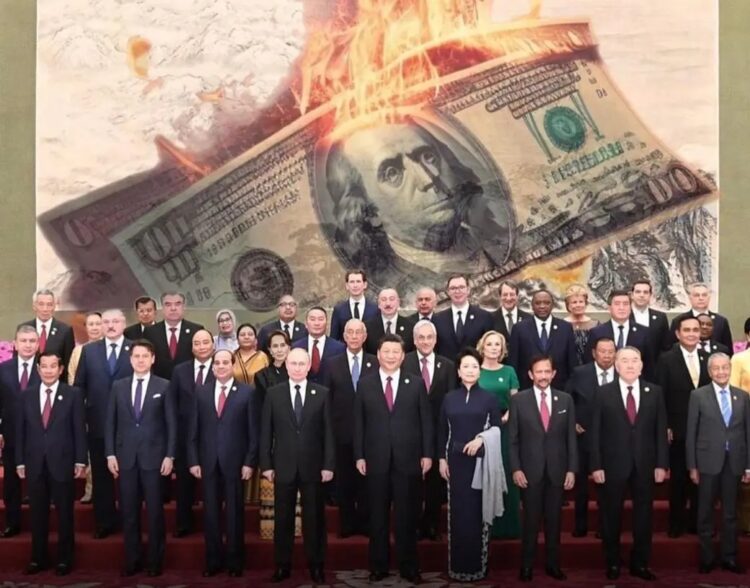The countries in the BRICS group —Brazil, Russia, India, China, and South Africa — are moving quickly to create their own digital currencies. These Central Bank Digital Currencies (CBDCs) are not just for modern payments. They are also part of a bigger plan: to reduce the world’s reliance on the U.S. dollar.
This movement is also putting pressure on popular U.S.-backed stablecoins like USDC and USDT, which are widely used in the crypto world for cross-border payments and trading. In this article, we’ll look at what BRICS countries are doing with digital money, how it could affect the global financial system, and what it means for the future of crypto geopolitics.
What Are BRICS CBDCs?
A CBDC is a digital version of a country’s national currency, controlled and issued by its central bank, and unlike Bitcoin or Ethereum, CBDCs are not decentralized. They are designed to facilitate faster, cheaper, and more secure payments.
BRICS countries are leading the way with different types of CBDCs:
- China’s digital yuan is already being tested in major cities, with people using their phones to make payments just like with cash or WeChat Pay. It’s even being used at international events like the Olympics.
- India is running its own digital rupee pilot in several regions.
- Russia, Brazil, and South Africa are also exploring and testing their own versions.
These CBDCs are being designed not just for domestic use but for trade between BRICS countries, and if successful, they could allow BRICS nations to trade with each other using their own digital money, not the U.S. dollar.
The Push for De-Dollarization

De-dollarization means reducing the use of the U.S. dollar in global trade and finance, and many countries are frustrated with relying too much on the dollar, especially when they face sanctions or need to avoid U.S. banking systems.
By using BRICS CBDCs or the digital yuan, countries can make cross-border payments without going through U.S. systems. This can give them more freedom and control over their economies.
This trend doesn’t seem to be slowing down anytime soon, as evidenced by China’s recent trade deals with Russia and other countries that use their local currencies. If these agreements start using CBDCs, it could be a major step toward a new financial system.
How This Could Affect USDC and USDT
In the crypto world, USDC and USDT are two of the biggest stablecoins. They are linked to the U.S. dollar and used by traders, businesses, and even regular people to store value and move money across borders.
So far, these USD-backed stablecoins have been very popular because they are trusted and stable; however, if more countries begin using BRICS digital currencies, the demand for dollar-based stablecoins could decline, especially outside the U.S.
This shift could make people and companies in Asia, Africa, and South America prefer digital currencies that match their local systems, rather than relying on U.S. stablecoins.
The Bigger Picture: Crypto Geopolitics
The rise of BRICS CBDCs shows how money and politics are closely connected, with countries trying to build payment systems that match their political goals.
The U.S. has relied on the dollar’s dominance to help shape global policy, but if digital yuan or BRICS CBDCs start being used more widely, that influence could shrink.
This is why many experts see crypto geopolitics as a growing field within the crypto space; it’s not only about which coin is most popular but about who controls the money system, and with BRICS moving fast, the world could be heading toward a multi-currency digital economy.
What It Means for the Future
We are still in the early days of this shift. USDC and USDT are still strong and trusted. But the growth of BRICS CBDCs is something to watch.
In the long run, we may see a world where people use different types of digital money, depending on where they live or do business, and this could lead to more competition, better services, and a stronger focus on privacy and freedom.
At the same time, the U.S. government may need to speed up its own plans for a digital dollar to stay in the game because if the dollar falls behind in the digital race, it could lose some of its global power.
In Conclusion,
The move by BRICS nations to build their own CBDCs is one of the most important financial stories of our time. It could change how we use money, how we trade, and who leads the digital future.
For now, USDC and USDT still hold their ground. But as crypto geopolitics heats up, we may see new leaders in the world of stablecoins and cross-border payments.
Disclaimer: This article is intended solely for informational purposes and should not be considered trading or investment advice. Nothing herein should be construed as financial, legal, or tax advice. Trading or investing in cryptocurrencies carries a considerable risk of financial loss. Always conduct due diligence.
If you want to read more market analyses like this one, visit DeFi Planet and follow us on Twitter, LinkedIn, Facebook, Instagram, and CoinMarketCap Community.
Take control of your crypto portfolio with MARKETS PRO, DeFi Planet’s suite of analytics tools.”





















